Create thriving pollinator borders by planting native species in clusters, ensuring continuous blooms across seasons. Layer tall, medium, and low plants with diverse flower shapes to attract varied pollinators. Enrich soil with compost and implement water conservation strategies. Use companion plants for natural pest control and provide nesting materials like hollow stems and bare soil patches. Schedule maintenance around pollinator lifecycles and save seeds for sustainable propagation. These ten practices will transform your garden into a buzzing ecosystem.
Native Plant Selection for Pollinator-Friendly Borders
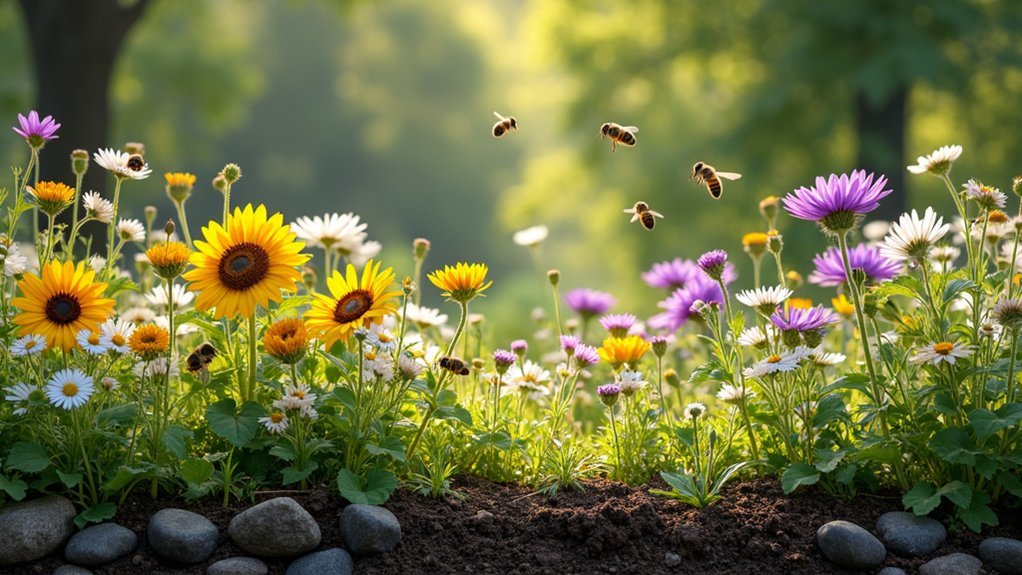
When designing your pollinator-friendly garden, native plants should form the backbone of your planting strategy. These plants have co-evolved with local pollinators, providing ideal nectar sources and habitat that non-native species often can’t match.
Choose powerhouses like Milkweed, Coneflower, and Black-eyed Susan to attract diverse beneficial insects. Plant these pollinator-friendly plants in clusters rather than individually—this increases foraging efficiency for bees and butterflies as they collect pollen and nectar.
For maximum impact, select varieties that bloom at different times to establish a continuous food source throughout the growing season.
Don’t forget to incorporate native grasses like Little Bluestem, which provide essential structural diversity and nesting sites for ground-dwelling bees, creating a complete ecosystem in your border.
Creating Multi-Season Blooming Sequences
How can your garden become a continuous buffet for pollinators? The secret lies in thoughtful planning of flowering plants that bloom sequentially throughout the growing season.
Start by selecting native pollinator favorites that emerge in early spring, like spring beauty, to support newly awakened bees. Continue the progression with summer bloomers such as purple coneflower, then shift to late-season standouts like goldenrod and asters.
A thoughtful progression of native blooms transforms your garden into a season-long pollinator haven.
Group similar-blooming plants together to create vibrant, easy-to-spot feeding stations that enhance foraging efficiency.
Monitor your garden’s performance and adjust plantings to address any gaps in the blooming sequence. This responsive approach guarantees your pollinator habitat meets seasonal needs year-round – from the first spring emergence to fall migration and winter preparations.
Your carefully orchestrated bloom succession becomes a lifeline for local pollinator populations.
Layering Techniques for Border Biodiversity
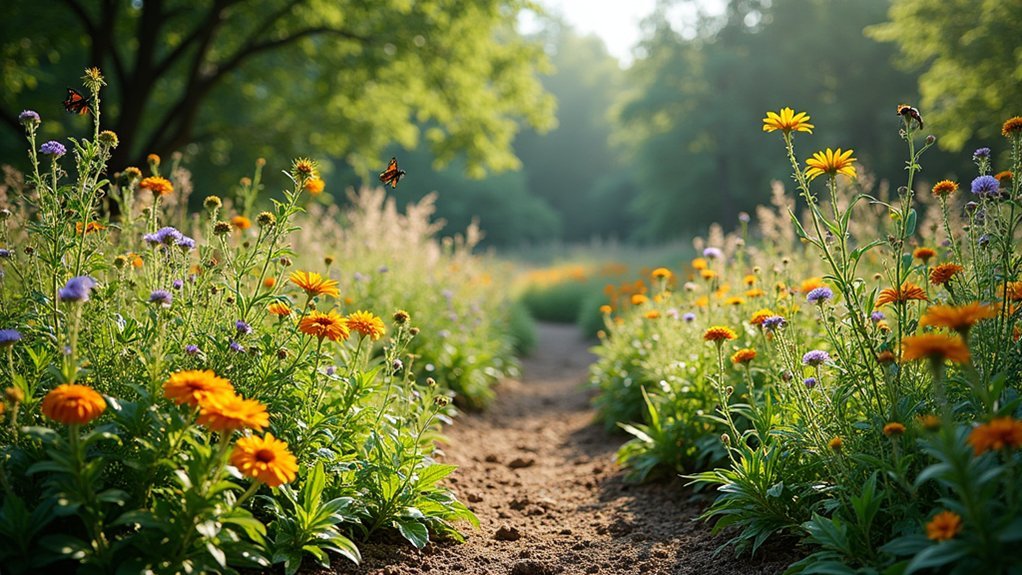
Creating a multi-dimensional garden border isn’t just visually appealing—it’s a critical strategy for supporting diverse pollinator populations.
Structure your border with taller native plants at the back, medium-height species in the middle, and ground-hugging varieties in front to maximize sunlight exposure and create varied habitats.
Incorporate plants with different flower shapes and bloom times throughout each layer. This approach guarantees continuous nectar sources while providing essential shelter for ground-nesting bees and other pollinators.
Include specific host plants for butterfly larvae as part of your habitat restoration efforts.
The most effective borders combine native perennials, annuals, and flowering shrubs across all layers.
This diversity not only attracts more pollinators but also strengthens your garden’s resilience and ecological function throughout the growing season.
Natural Pest Management in Border Plantings
When designing your pollinator-friendly borders, consider integrating companion plants like marigolds and nasturtiums that naturally repel common garden pests while supporting beneficial insects.
You’ll maximize your garden’s health by strategically placing predator-attracting plants such as yarrow, dill, and coneflowers that entice ladybugs, lacewings, and parasitic wasps to handle pest control naturally.
These thoughtful plant combinations create a self-regulating ecosystem that reduces your need for intervention while fostering a thriving community of pollinators and beneficial insects.
Companion Planting Strategies
Thoughtful arrangement of complementary plants along your garden borders can create a natural defense system against pests while supporting diverse pollinator populations.
Pairing marigolds with tomatoes is a classic companion planting strategy that naturally deters pests while attracting beneficial insects to your pollinator garden.
Try incorporating herbs like basil and mint throughout your borders—they’ll repel harmful insects while providing nectar for pollinators.
Nasturtiums serve dual purposes by attracting aphids away from valuable crops while supporting pollinator activity.
When you intercrop different plant species, you’re enhancing biodiversity and improving soil health, creating a more balanced ecosystem.
For maximum effectiveness, plan your borders with a variety of flowering plants that bloom in succession throughout the season.
This continuous availability of flowers guarantees sustained food sources for pollinators while maintaining natural pest control year-round.
Predator-Attracting Plants
Guardians of your garden, predator-attracting plants serve as the foundation of organic pest management systems. By incorporating dill, fennel, basil, and cilantro into your borders, you’ll attract ladybugs and lacewings that enthusiastically devour harmful pests.
Don’t overlook the power of native flowers like goldenrod and asters, which can boost beneficial insect populations by up to 50%. You’ll create a self-regulating ecosystem where chemical interventions become unnecessary.
Strategic placement of yarrow and other dense-foliage plants provides essential shelter for these beneficial insects, ensuring they stick around to patrol your garden.
When you integrate these predator-attracting plants throughout your borders, you’re establishing a balanced ecosystem where natural pest management flourishes, protecting your pollinators and promoting biodiversity.
Organic Soil Amendment Strategies for Thriving Borders
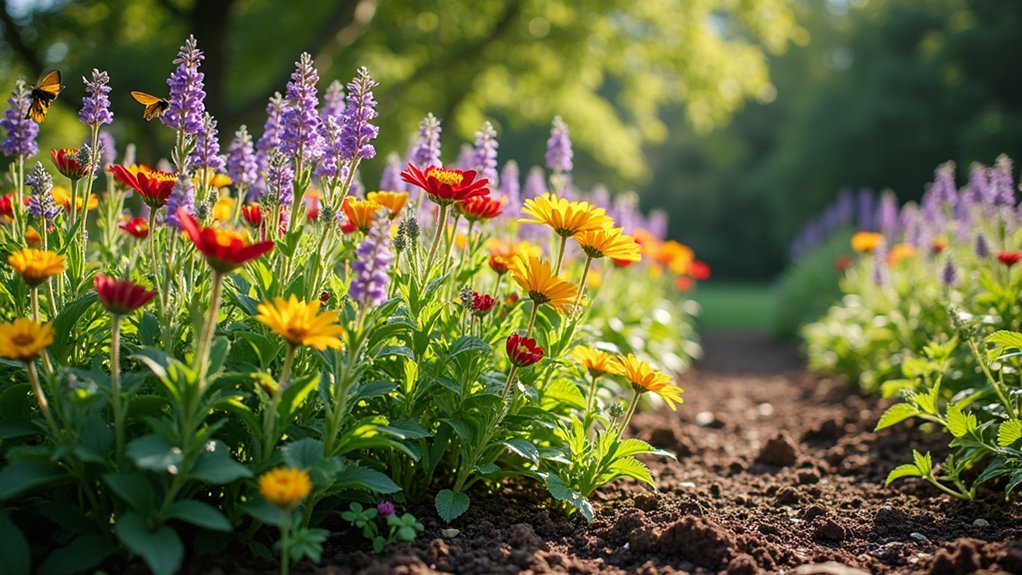
Enriching your borders with compost creates a thriving ecosystem where beneficial microorganisms break down organic matter into plant-available nutrients.
These microbial partnerships help your pollinator plants develop stronger root systems and enhanced resilience against environmental stressors.
You’ll notice improved plant vigor and bloom production as soil life flourishes, creating a more attractive habitat for bees, butterflies, and other essential pollinators.
Compost Enriches Ecosystems
Three fundamental principles make compost a cornerstone of organic pollinator support: nutrient cycling, soil structure improvement, and biodiversity enhancement.
When you incorporate compost into your garden borders, you’re creating a self-sustaining ecosystem that naturally attracts pollinators.
Your garden’s soil web thrives with beneficial microorganisms that suppress plant diseases and reduce the need for harmful chemicals.
This protection extends to visiting pollinators who benefit from chemical-free environments.
Compost also greatly improves moisture retention, allowing native pollinator-friendly plants to flourish with less irrigation.
Soil Microbial Partnerships
Beneath the visible wonder of your garden’s surface lies a complex world of soil microbial partnerships that directly influence pollinator health.
When you incorporate organic amendments like compost, you’re fostering a vibrant underground ecosystem that can increase microbial biomass by up to 30%.
Soil matters more than most gardeners realize.
Adding diestel structured compost delivers immediate soil importance, enriching your pollinator habitat with beneficial microorganisms.
Your garden’s health begins from the ground up—composting yard clippings and kitchen scraps creates natural amendments that support both plant health and attract beneficial insects.
Water Conservation Methods for Pollinator Boundaries
Water conservation within pollinator boundaries isn’t just environmentally responsible—it’s vital for maintaining healthy habitats that attract and sustain beneficial insects.
By implementing drip irrigation systems, you’ll deliver water precisely where plants need it, minimizing waste while promoting robust growth.
Consider installing rain gardens to naturally filter runoff, providing pollinators with accessible water while improving soil moisture retention.
Select native drought-tolerant plants like sedum and speedwell to reduce irrigation requirements, especially in drier regions.
Harvest rainwater with strategically placed barrels to create a sustainable water source that decreases dependence on municipal systems.
For maximum efficiency, use zone-specific timers that customize watering schedules based on the unique needs of different garden sections.
These practices guarantee your pollinator boundaries thrive while conserving precious water resources.
Incorporating Nesting Materials and Shelter Spaces
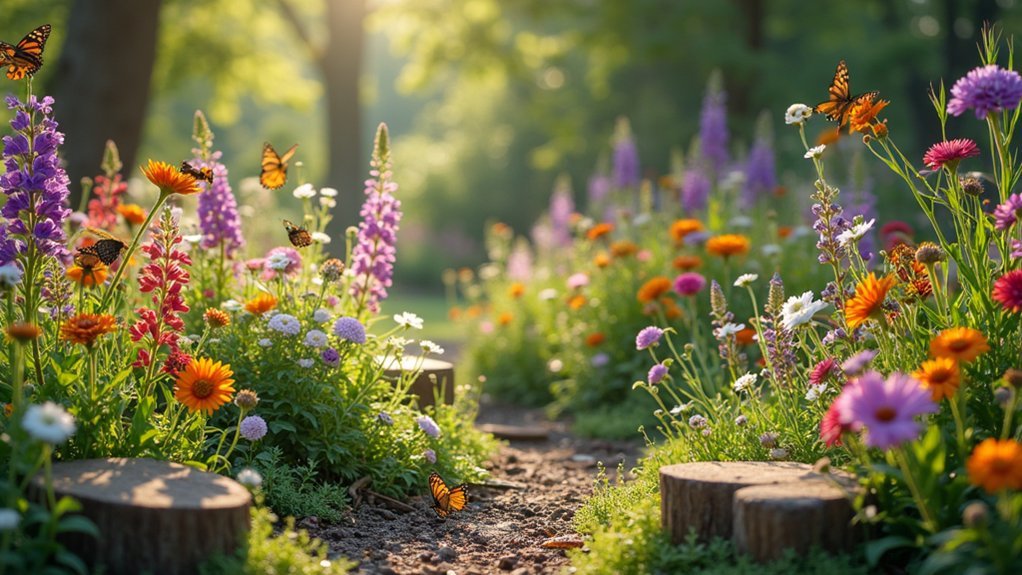
Successful pollinator habitats extend beyond plants and water to include vital shelter options.
You’ll greatly boost pollinator species diversity by providing various nesting materials throughout your garden borders. Incorporate hollow stems, straw, and wood blocks with different-sized holes to accommodate solitary bees, which represent most bee species.
Don’t overlook ground-nesting pollinators—leave patches of bare soil undisturbed and create “bee hotels” using natural materials like twigs, logs, and leaves.
Ground nesters need your help too—clear soil patches and simple structures of natural materials provide essential sanctuary.
These shelter spaces not only protect insects from predators and harsh weather but also serve as essential overwintering sites.
For maximum effectiveness, maintain these areas regularly by removing old materials and renewing resources.
This simple practice dramatically increases occupancy rates and supports biodiversity across your garden ecosystem, ensuring robust pollination services year after year.
Maintenance Timing to Protect Pollinator Lifecycles
Thoughtful timing of garden maintenance activities can dramatically impact pollinator survival rates throughout their lifecycle stages.
Schedule mowing and pruning outside native plants’ blooming periods to guarantee pollinators maintain access to crucial nectar sources.
During the first few years of establishment, prioritize weed control when pollinator-friendly plants are developing, allowing them to thrive without competition.
Always avoid pesticide applications during spring and summer when pollinator activity peaks, protecting adult bees from harmful chemical exposure.
Align your maintenance schedule with seasonal pollinator behaviors, particularly guaranteeing shelter availability before overwintering phases.
Implement regular monitoring for pests and diseases during the growing season, allowing for timely, minimally disruptive interventions that preserve ecosystem health while supporting complete pollinator lifecycles.
Companion Planting for Enhanced Border Ecology
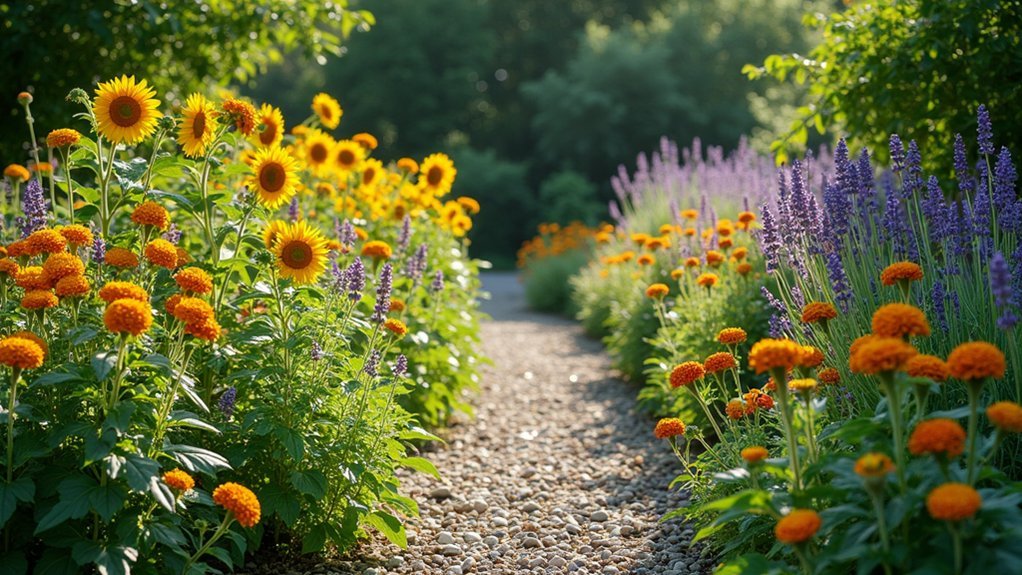
Strategic companion planting transforms ordinary garden borders into thriving ecological powerhouses for pollinators. By pairing compatible plants, you’ll create a balanced ecosystem that fulfills what pollinators need while naturally managing pests.
Plant marigolds alongside vegetables to repel nematodes and aphids, while adding borage and nasturtium to attract beneficial insects that prey on garden pests. These natural predators provide free pest control services while supporting pollinator populations.
Don’t overlook flowering herbs like dill and cilantro, which offer essential nectar sources while supporting diverse insect communities.
Combine deep-rooted plants with shallow-rooted species to maximize nutrient uptake and resource efficiency. This strategic approach can boost yields by over 20% while creating a vibrant habitat where pollinators thrive year-round.
Seed Saving and Propagation for Sustainable Borders
Beyond companion planting, your garden’s sustainability hinges on seed saving and propagation techniques. When you collect seeds from native plants, you’re preserving local genetic diversity that native bees and other pollinators have co-evolved with over thousands of years.
Select your healthiest, most vigorous plants for seed saving to guarantee strong future generations. Properly dried and stored seeds remain viable for years, eliminating the need to purchase new ones each season. You’ll create a self-sustaining cycle of food sources for pollinators while adding continuous visual interest to your borders.
Choose vigorous plants for seed saving – creating a self-sustaining food cycle for pollinators while ensuring your borders thrive year after year.
Don’t limit yourself to seeds alone. Techniques like division, cuttings, and layering allow you to increase plant populations while maintaining genetic traits that local pollinators depend on.
This diverse approach guarantees your borders remain ecologically valuable throughout the growing season.
Frequently Asked Questions
What Is the Best Landscaping for Pollinators?
The best landscaping for pollinators includes diverse native plants that bloom sequentially, clustered flowers for easy foraging, shallow water sources, and no chemical pesticides. You’ll attract more bees and butterflies with these features.
What Is the Most Effective Pollinator Principle?
The most effective pollinator principle is plant diversity. You’ll attract more pollinators when you plant native species that bloom throughout the season, creating continuous food sources while avoiding pesticides that harm beneficial insects.
What Pesticide Is Safe for Pollinators?
You’ll find neem oil and insecticidal soap are safest when used as directed. Apply diatomaceous earth carefully and always in the evening when pollinators aren’t active. Avoid systemic insecticides entirely—they remain toxic long after application.
How to Prepare Ground for a Pollinator Garden?
Clear weeds, loosen soil, and add organic compost. You’ll want to test soil drainage and pH, then choose a sunny spot with protection from winds. Don’t use chemical herbicides that harm pollinators.
In Summary
You’re now equipped to transform your garden borders into vibrant pollinator havens using these organic practices. By selecting native plants, creating year-round blooms, and embracing natural pest control, you’ll foster a thriving ecosystem that benefits both your garden and local biodiversity. Remember, your thoughtful border management isn’t just beautiful—it’s providing essential habitat and food sources for the pollinators we all depend on.

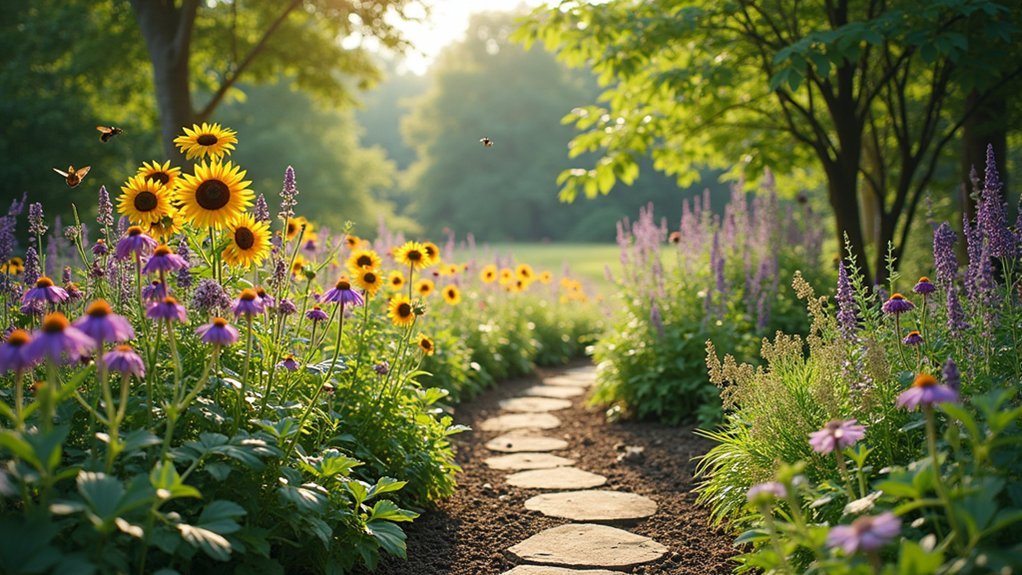



Leave a Reply